 Browns Archive
Browns Archive  Browns Game Vault: 9/14/63. Era Begins for HC Blanton Collier, FB Jim Brown, QB Frank Ryan.
Browns Game Vault: 9/14/63. Era Begins for HC Blanton Collier, FB Jim Brown, QB Frank Ryan.
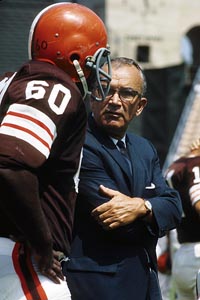 Our theme today is ‘change’. If you are familiar with the dynamics that animated the relationships involving Paul Brown, Art Modell, Jim Brown, and Blanton Collier in the early 1960s, you have an inkling of where we are going with this.
Our theme today is ‘change’. If you are familiar with the dynamics that animated the relationships involving Paul Brown, Art Modell, Jim Brown, and Blanton Collier in the early 1960s, you have an inkling of where we are going with this.
Change is inevitable, of course, and its desirability depends on one’s perspective. It can be fleeting or permanent; imperceptible or life-altering.
Technology is a prime example of the shifting landscape in which we live. Insurance companies, known for looking to subtract depreciation from the insured value of property, have no problem insuring computer equipment at full replacement cost. This, in a nutshell, illustrates the general rule that successive generations of such items generally cost less and less. We also know that updated technology often includes significant improvements.
Not that I am proud of this, but I have not completely joined the 21st Century’s technology explosion. I don’t tweet; I know about social media through others, including my high school- and college- age kids.
A few chuckles come to mind. A comedian’s children were away at college. He and his wife had just bought smart phones. Only, they didn’t know how to operate them; they needed an expert’s help. “Oh well, time to have another kid!”
I also liked the bit about the mom who was computer-ignorant. (Yelling, in public) “Your father likes MY FACE now. He was on MY FACE all night last night!”
I am not that bad. But I get my share of knowing smiles from our girls. When I first owned a cell phone (years after the rest of the family), I tried to text “Hi”. I hit an “H”, and an “I”, and all was good. I hit the button again, and now I’m looking at “gig”. Crap. I hit it again, and again,… so I ended up sending the greeting: “gigggggggg”. They understood.
I felt like a blithering idiot:
“Hi, Dad!
(After four agonizing minutes) “gigggggggg”.
I often need to answer a text from one of the girls, who are arriving at a destination and are just checking in. I recall the first time I had to send a reply, to acknowledge. I hit a button. “A”. I don’t think I actually wanted an “A”. I hit another button. So I’m standing there, looking at the “A+” that I had just somehow typed. Huh. Good enough. I sent it. I liked it. Even today, and probably forever, an “OK” message texted from me to them will remain an “A+”.
***
Last week, we looked at a highlight of the Paul Brown/Otto Graham Cleveland Browns. In many meaningful ways, the 1960s were an extension of that era; in several other ways, they were fundamentally different. Things had changed.
The beginning of the end of Paul Brown’s run as the head football man in Cleveland came when Art Modell began visiting the team’s facility, in 1960. The imminent sale of the Browns in 1961 had not been publicized. But as Cleveland fans know, a whiff of smoke may signal a coming firestorm. The brash, young ad executive from New York emerged victorious in his struggle to win out over a group of local businessmen who were led by the head of Diamond Alkali (which eventually became Diamond Shamrock, on its way to being acquired by Valero Energy Corporation). Modell is said to have leveraged himself to the hilt in coming up with the as-yet-unheard-of $4 million price to purchase the NFL franchise. As a result of the sale, Paul Brown’s personal wealth grew due to the increase in value of his minority stake. Brown was said to have been satisfied that his role with the team would not change.
On the day the sale was announced, Art Modell addressed a swarm of Cleveland news reporters. He charmed them, entertained them, and slid in a comment that indicated he and Paul Brown would be “partners” in running the football operations. Privately, Brown seethed over Modell’s comment that they would be “consulting frequently”. Modell stopped by Brown’s office during his initial tour of the team offices, offering some light humor that fell flat. Brown stared at Modell before turning back to his football preparation. Right from the start, Brown scoffed at the ‘unearned’ admiration for his new owner, while Modell lived for adulation- from the public, from the press, and from his head coach. One might say, the tone was set.
Nobody ever disputed Paul Brown’s genius. Cleveland fans can recite the litany of innovations he brought to professional football. Like studying game film, grading players, timing the 40 yard dash (instead of 100 yards), intelligence tests, the facemask, radio receivers in the quarterback’s helmet, playbooks. Calling plays…
Star fullback Jim Brown was, and always would be, impressed with the old coach. For instance, on the matter of the difficult tests the players had to take: they cheated. But he apparently knew this. Through the sharing of information between players, and the composing of crib notes, the team gained a thorough knowledge of every position group’s responsibilities.
The coach’s innovations spread to the racial makeup of the team. Back to the team's 1946 beginnings, he didn’t have just one or two token black players on the roster; he acquired the best football players available, regardless of race. The result was that he was seen in some circles as the football equivalent of baseball’s Branch Rickey. Truth be told, Paul Brown didn’t seem to care about societal statements. He just wanted to win football games. (There was a flip side to that; Paul Brown did embody confusing contradictions. When Bobby Mitchell first joined the team, it was beginning to look like the Browns had two superstars in the backfield. Mitchell was suddenly relegated to the bench, which caused Jim Brown and other players to wonder if Paul Brown was only prepared to have one black superstar.)
But compared to the 1940s and much of the 1950s, Paul Brown’s football team had drifted into mediocrity. Fans and reporters alike were wont to declare that the game had “passed him by”. I agree (with the clarifier that when “passed by”, one may eventually respond and catch up again).
Jim Brown noted that the complexion of the roster had become transformed, from “brawling thugs” to “the straightest team in football”. Jim thought 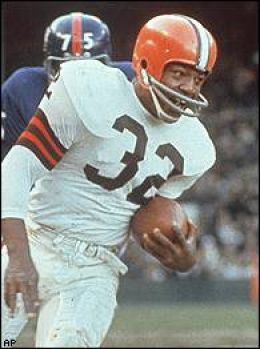 Paul Brown had made the team over on purpose, in order to be able to continue to instill fear as a tool to force compliance. A man half their size had the entire team under a state of “collective terror”- even Jim Brown. Jim Brown does admit to having an attitude as a player. He was one of the first stars in professional sports who asserted his individualism. It was evidenced by how he practiced (he’d hold back if he felt his body needed to heal), and by how he played (if the situation seemed right, he was liable to drift from the designed play).
Paul Brown had made the team over on purpose, in order to be able to continue to instill fear as a tool to force compliance. A man half their size had the entire team under a state of “collective terror”- even Jim Brown. Jim Brown does admit to having an attitude as a player. He was one of the first stars in professional sports who asserted his individualism. It was evidenced by how he practiced (he’d hold back if he felt his body needed to heal), and by how he played (if the situation seemed right, he was liable to drift from the designed play).
Paul Brown’s ability to predict the success of a player had also begun to come into question. Over the previous couple seasons, he had traded (future HoFer) Willie Davis to the Packers, traded Bobby Mitchell to the Redskins (HoF), traded Bill Quinlan and Henry Jordan to the Packers (All-Pros), and traded Jim Marshall to the Vikings (All-Pro).
A large bone of contention critics had (especially among the players) was Paul Brown’s method of calling plays. For years, he famously sent in rotating messenger offensive guards with the instructions for the next play. Opposing defenses, led by such coaches as Vince Lombardi in Green Bay and Allie Sherman and Tom Landry in New York, began to implement pre-snap alignment switches. Also, Paul Brown’s play calling had become very predictable. Some teams, like the Giants, would know the next play before it had been passed on from the guard to the quarterback. Pre-snap adjustments weren’t even always necessary. The Browns’ offense began to occasionally disregard the called play. They would worry in the huddle about what the coach would say- the plan typically would be to say the play call was lost in the translation. If the play was successful, “PB” kept quiet. (Truth be told, Otto Graham admitted to changing the play at times, years earlier. He also noted that he’d hear nothing from the coach- if the play worked.)
Jim Brown has declared that the offense had gotten ultra-conservative. He wondered why the sweep had somehow been abandoned from the Browns’ attack. The fullback was able to bust through tackles head-on, of course (especially when using a brutal forearm), but he was also fully capable of running around and 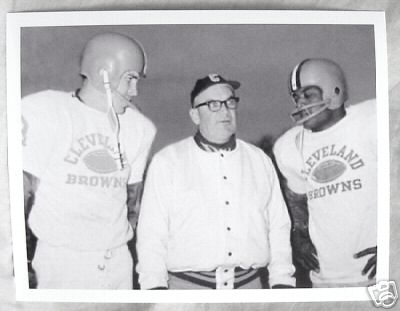 away from defenders. The fullback is on record as believing the coach had begun to fear the top teams in the league, and was afraid to be creative, or even throw the ball downfield much
away from defenders. The fullback is on record as believing the coach had begun to fear the top teams in the league, and was afraid to be creative, or even throw the ball downfield much
Art Modell had become a friend of the players, including Jim Brown (Brown’s word was that he “courted” him, in a sense). The players, knowing the coach, were amazed that a carpetbagger owner from out of town would even consider buying ‘his’ team. They knew a clash was coming. Modell moved PB to a back office, began attending practices and standing behind the offensive huddle. They were two alpha males, with room for only one. Jim Brown maintains that Art did not sow the seeds of divisiveness among the players (as Paul Brown would later state), but that Art took full advantage of the situation.
When Paul Brown traded Bobby Mitchell to the Redskins for newly – drafted Ernie Davis after the 1961 season, Art Modell was surprised and upset he'd been in the dark. Modell took over the contract negotiations with Davis, angering Paul Brown. PB was disgusted by Modell’s constant searching for publicity. Modell had moved into his turf, and now was predicting a championship- setting the bar at its highest for the coach. Quarterback Milt Plum spoke to the press about the team not getting up for the big games, and Jim Brown backed him up.
A developing theme among various observers- fair or unfair- was that the main difference with the Browns was that Otto Graham retired, and highly-regarded assistant coach Blanton Collier had left to become head coach of the University of Kentucky. (Photo at right- Collier with QB Frank Ryan and Jim Brown).
But after the 1962 season, Collier returned to the Browns. He was running the offense, and Paul Brown allowed him to implement a system in the preseason that included the option of audibles- changing the play that was called. A newspaper article was run that complimented Collier. The practice was suddenly stopped by the head coach. It was another wedge between the coach and the team.
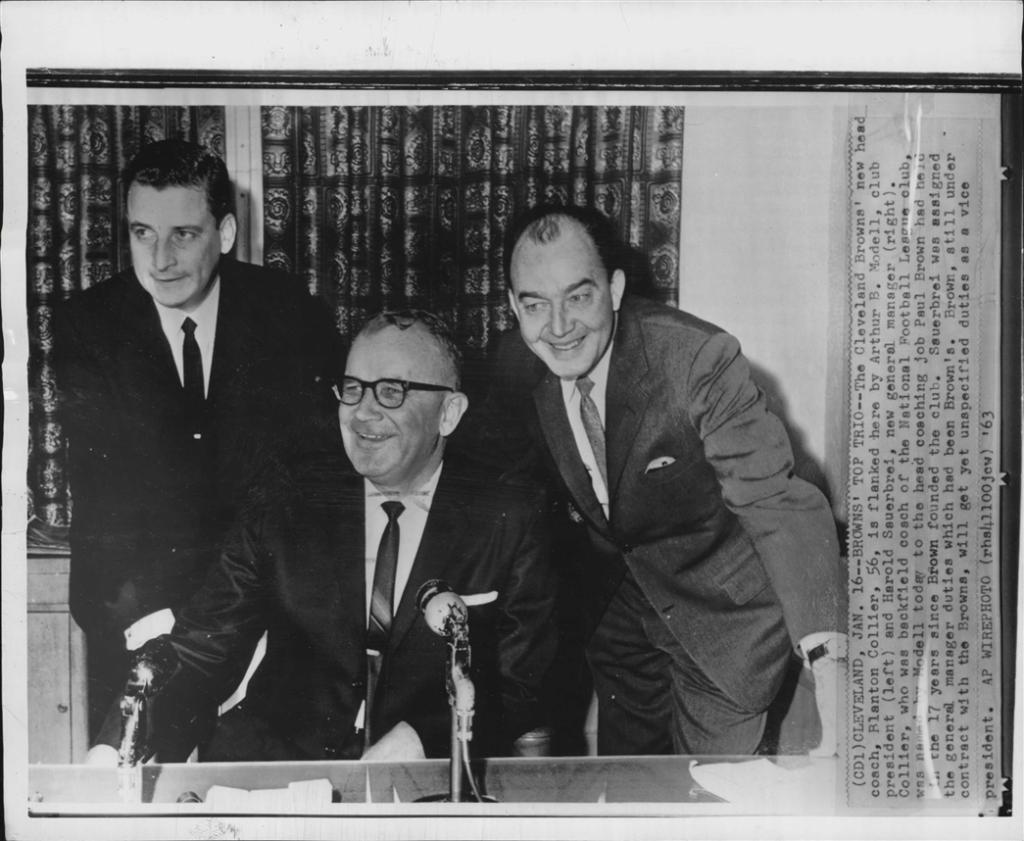 Art fired Paul Brown after the team went 7-6-1 in 1962, during the middle of a local newspaper strike. Some considered that a factor for the timing of the move. Brown had several years left on his contract, and Modell would honor it. Brown would spend some time in a vague capacity as player scout.
Art fired Paul Brown after the team went 7-6-1 in 1962, during the middle of a local newspaper strike. Some considered that a factor for the timing of the move. Brown had several years left on his contract, and Modell would honor it. Brown would spend some time in a vague capacity as player scout.
Here begs a question that will never be explained. Paul Brown was a meticulous planner. And a control freak. Years earlier, when original owner “Mickey” McBride had sold the Browns, he did so without Paul Brown’s knowledge or consultation. Brown learned of the sale while on a fishing trip in Canada. It is generally accepted that McBride did this intentionally, to show Brown who was the boss. So, Brown found himself vulnerable to changes in franchise ownership. The question: In this context, how did Paul Brown ever come to find himself on the losing end of a power play with Art Modell?
The new head coach was Blanton Collier. The long-time understudy had a personality that was diametrically opposed to Brown’s- he was quiet, easygoing, emotional, and very patient. He expected execution of assignments, but would not yell; he’d simply have a play run as often as needed during practice in order to get it right.
Collier allowed the offense to audible. He introduced an ‘option’ play for Jim Brown, allowing the runner to read and react to the blocking as he decided where to run. The players were to be consulted in forming game plans. The reins were taken off quarterback Frank Ryan, who was now liable to throw on any down and distance.
The Cleveland Browns opened the 1963 season at home, against Washington. They dominated the visiting Redskins in front of 58,000 fans, as the offense rolled up 543 total yards. Jim Brown alone accounted for 262 of those yards - 162 yards rushing and 100 receiving. Frank Ryan finished with 21 of 31 for 334 yards and two touchdowns.
The Redskins fumbled the opening kickoff, and the Browns recovered at the 23 yard line. Ryan eventually converted the turnover as Cleveland scored. The Browns remained in control for almost the entire game.
The Blanton Collier-led Browns began the season at 6-0. It was a new era. The winds of change were blowing on the shores of Lake Erie.
Thank you for reading. Sources included Out of Bounds, by Jim Brown and Steve Delsohn; Paul Brown, the Rise and Fall and Rise Again of Football's Most Innovative Coach, by Andrew O'Toole; Wikipedia; Sports Illustrated's online SI Vault.
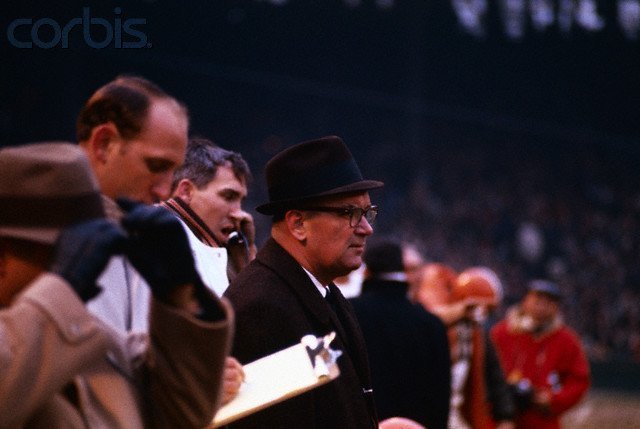
- NBA Announces 2013-2014 Schedule
- Browns Ink Sharknado
- Sharknado A No-Show For Rookie Camp
- Trent Richardson Out Until Training Camp
- Browns Sign Brandon Jackson
- Carrasco Suspended Eight Games
- Browns Add to Wide Receiver Depth with David Nelson
- Browns Need to Learn from Past Draft Mistakes
- Browns Release Chris Gocong and Usama Young
- Browns Missing on Grimes Disappointing, But Not The End
The TCF Forums
- Official- Browns Coach Search/Rumors
mattvan1 (Tuesday, January 21 2014 1:19 PM) - Movies coming out
rebelwithoutaclue (Tuesday, January 21 2014 12:56 PM) - 2015 Recruiting
jclvd_23 (Tuesday, January 21 2014 12:38 PM) - The 2014 Offseason Thread
Larvell Blanks (Tuesday, January 21 2014 12:25 PM) - Chris Grant's first 3 drafts
Kingpin74 (Tuesday, January 21 2014 10:13 AM) - Mike Brown
YahooFanChicago (Monday, January 20 2014 11:15 PM) - 2014 Hoops Hockey Hijinx
jpd1224 (Monday, January 20 2014 4:44 PM) - 2014 Recruiting
jclvd_23 (Monday, January 20 2014 2:26 PM) - Wish List - #4 Pick
Hikohadon (Monday, January 20 2014 1:26 PM) - #1 overall pick Anthony Bennett
TouchEmAllTime (Sunday, January 19 2014 1:28 PM)



